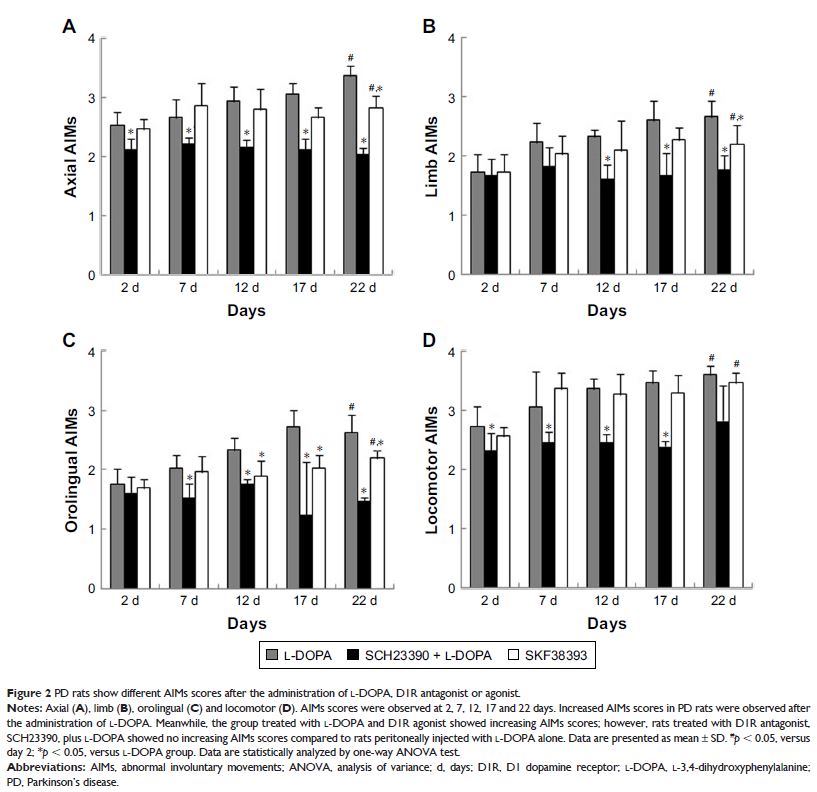9 0 6 7 6
论文已发表
注册即可获取德孚的最新动态
IF 收录期刊
- 2.6 Breast Cancer (Dove Med Press)
- 3.9 Clin Epidemiol
- 3.3 Cancer Manag Res
- 3.9 Infect Drug Resist
- 3.6 Clin Interv Aging
- 4.8 Drug Des Dev Ther
- 2.8 Int J Chronic Obstr
- 8.0 Int J Nanomed
- 2.3 Int J Women's Health
- 3.2 Neuropsych Dis Treat
- 4.0 OncoTargets Ther
- 2.2 Patient Prefer Adher
- 2.8 Ther Clin Risk Manag
- 2.7 J Pain Res
- 3.3 Diabet Metab Synd Ob
- 4.3 Psychol Res Behav Ma
- 3.4 Nat Sci Sleep
- 1.9 Pharmgenomics Pers Med
- 3.5 Risk Manag Healthc Policy
- 4.5 J Inflamm Res
- 2.3 Int J Gen Med
- 4.1 J Hepatocell Carcinoma
- 3.2 J Asthma Allergy
- 2.3 Clin Cosmet Investig Dermatol
- 3.3 J Multidiscip Healthc

D1R/Shp-2 复合物的异常激活参与左旋多巴诱导的、6-羟基多巴胺损伤帕金森病大鼠的运动障碍
Authors Wu N, Wan Y, Song L, Qi C, Liu Z, Gan J
Received 15 January 2018
Accepted for publication 2 May 2018
Published 5 July 2018 Volume 2018:14 Pages 1779—1786
DOI https://doi.org/10.2147/NDT.S162562
Checked for plagiarism Yes
Review by Single-blind
Peer reviewers approved by Dr Andrew Yee
Peer reviewer comments 3
Editor who approved publication: Professor Wai Kwong Tang
Background: Levodopa-induced dyskinesia (LID) is a troublesome problem in the
treatment of Parkinson’s disease (PD). The mechanisms of LID are still
mysterious. Recently, the interaction between Shp-2 and D1 dopamine receptor
(D1R) has been identified to be indispensable in the D1R-mediated extracellular
signal-regulated kinases 1 and 2 (ERK1/2) activation and the occurrence of LID.
However, the role of Shp-2 in the D1R-mediated signaling pathway of dyskinetic
rat models is not fully clear. We designed this study with the purpose of
exploring the role of D1R/Shp-2 complex in the D1R-mediated signaling pathway
in the occurrence of LID.
Materials and methods: The 6-hydroxydopamine (6-OHDA) was injected
unilaterally to produce the rat models of PD. Successful PD rat models were
randomly divided into three groups to receive the treatment with
L-3,4-dihydroxyphenylalanine (L-DOPA) + benserazide, L-DOPA + benserazide + D1R
antagonist (SCH23390) or D1R agonist (SKF38393). Abnormal involuntary movements
were assessed in different groups during the treatment. The interaction between
D1R and Shp-2 was confirmed in the sham and LID rats through the methods of
coimmunoprecipitation. In addition, the levels of p-Shp-2, p-ERK1/2 and p-mTOR
were determined by Western blot in different groups.
Results: After the treatment with L-DOPA + benserazide
for 22 days, PD rats presented with dyskinesia. D1R agonist, SKF38393,
induced similar involuntary movements in PD rats. In contrast, the dyskinetic
movements were not induced by coadministration of L-DOPA + D1R antagonist
(SCH23390). The interaction between D1R and Shp-2 in the normal rats was kept
stable after the long-term use of L-DOPA. Moreover, we found that the pulsatile
levodopa administration induced hyperphosphorylation of Shp-2, ERK1/2 and mTOR,
while the coadministration of L-DOPA and D1R antagonist, SCH23390, did not
induce the hyperphosphorylation of these proteins.
Conclusion: These data verified the existence of D1R/Shp-2
complex and its crucial role in the D1R-mediated signaling pathway in
dyskinetic rats. Focus on the D1R/Shp-2 complex might be a potential treatment
of LID in the future.
Keywords: Parkinson’s
disease, dyskinesia, levodopa, D1 receptors, Shp-2
